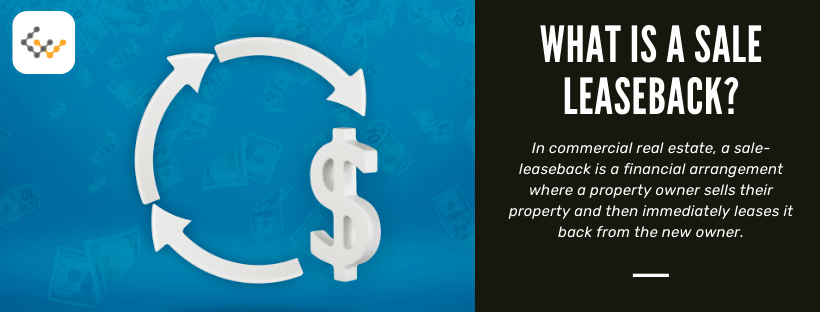What is a Sale Leaseback in Commercial Real Estate?

What is a Sale Leaseback?
A real estate sale leaseback is a commercial property transaction between a property owner and a property investor. The current owner sells their property to the investor, and then leases it back for a long-term period.
The current owner is called a seller-lessee or seller-tenant, and the investor is a buyer-lessor. Both terms reflect the dual roles of each party in the arrangement.
The seller-lessee is almost always a business, as investors typically don’t sell properties and then continue their own operations in the property. The buyer-lessor is most often an investor, whether an individual, partnership, firm or other entity. In less common situations, however, the buyer-lessor could be another tenant in the building.
Answer a few questions and get custom mortgage quotes. We'll match you with offers from our network of 650+ lenders.
How Does a Commercial Real Estate Sale-Leaseback Work?
A typical sale leaseback is structured in two parts. The first is a fairly straightforward commercial real estate sale, although it can come with all the complexities of these sales. The second is a long-term lease between the seller and buyer.
Lease terms are usually long-term, such as 10 to 20 years. They can be structured any way that the seller and buyer agree to, though. As with any commercial real estate lease, this also details rent, responsibilities and all other terms.
The two components are part in parcel with each other. They’re both negotiated and agreed upon during the selling process, and not with the sale first and lease second. The purchase sale is effectively contingent on a lease agreement.
Why Do Commercial Property Sale-Leasebacks?
Commercial property sale-leasebacks can be attractive to both seller and buyer for a few different reasons.
The arrangement allows sellers to focus on their core competencies if commercial property management isn’t their area of expertise. For instance, a medical practice might sell an owned building. The physicians and office manager could then focus on providing medical care, rather than leaky pipes, roof replacements and finding tenants.
The arrangement also lets sellers leverage capital that’s otherwise tied up. Sellers might liquidate their equity in a building to expand operations, perhaps opening more locations, investing in major specialized equipment, or going into a new market.
Sellers can achieve either or both of these purposes, without having to find a new location for their current operations.
Buyers are able to acquire a commercial property that already has an established long-term tenant, often an anchor tenant. Having an established tenant ensures immediate cash flow to assist with operating expenses. If the seller is a large anchor tenant, they may be used to attract other tenants.
Immediately having an established tenant is beneficial when purchasing any commercial property, but it’s especially so when purchasing a specialized building. A medical office or specific manufacturing facility could otherwise take some time to lease.
For these reasons, commercial real estate sale-leasebacks are common for medical buildings. They’re sometimes used for manufacturing facilities, office buildings, and retail spaces, and could be used for any non-residential property.
Pros and Cons of Commercial Real Estate Sale-Leaseback
The Pros to Seller and Buyer
A commercial real estate sale-leaseback can give both seller and buyer benefits that other commercial property transactions don’t offer.
Seller:
- Liquidity: Converts equity that’s tied up in real estate into cash, providing capital for expansion, debt reduction or other investments.
- Balance Sheet Improvement: Leasing rather than owning can improve financial ratios, making the company more attractive to investors and lenders.
- Operations: Businesses that focus on anything other than real estate can free themselves of the responsibilities that come with building ownership. This can be especially helpful to small practices and businesses, where there isn’t enough staff specifically for property management.
Buyer:
- Stable Investment: The lease immediately secures a long-term tenant and predictable income stream.
- Finding Tenants: The seller often has a space with a specialized build-out. This ensures the space is already filled. The seller could also be used to attract other tenants if they’re an anchor.
The Cons to Seller and Buyer
That isn’t to say that sale-leasebacks don’t have drawbacks. As with any real estate transaction, they aren’t the best option in every situation.
Seller:
- Loss of Property Control: The seller no longer owns the property and must adhere to lease terms.
- Long-term Costs: Over time, leasing may be more expensive than owning. The seller no longer builds equity, and they can’t benefit from additional appreciation.
- Lease End: Unless outlined in the lease, the buyer may not be obligated to renew a lease when it ends. Whether this is an issue depends on the business’s long-term plan.
Buyer:
- Tenant Risk: The buyer is locked into a long-term lease with the seller, which creates risk if the tenant defaults on rent or is generally difficult.
- Building Condition: When businesses sell a property, they sometimes have put off maintenance and repairs knowing that the building will soon be sold. The buyer should confirm the property’s condition with an inspection.
Commercial Sale-Leaseback Example
For an example of a commercial sale-leaseback, consider a private medical practice that purchased its building. At the time, buying may have been the best way for the practice to get and build-out a facility around its desired location.
The practice has the space it needs now, however, and managing the building is taking physicians’ time away from seeing patients. Selling the building would allow physicians to focus on billable patient care, and a long-term lease would ensure the practice could keep its space.
At the same time, this could give an investor the opportunity to diversify with established medical real estate.
The building may be sold as-is, perhaps for a minor discount due to repairs that are needed, and with a 20-year lease for the medical practice.
Tax Implications of Commercial Sale-Leaseback
Sale-leasebacks can have significant tax implications for sellers. Sellers should be prepared for capital gains tax when they sell, but then can usually deduct lease costs from their revenues.
With regard to the buyer’s tax situation, a commercial sale-leaseback is essentially like purchasing a property with a long-term tenant already established. This is fairly straightforward.
3 Important Things to Consider Before Executing a Commercial Sale-Leaseback
- Lease Terms: The lease duration, rent, and escalation clauses should be carefully negotiated.
- Property Valuation: Accurate valuation ensures a fair sale price. Each side needs to feel they were treated fairly by the other, so they respect each other going into the lease.
- Tenant Creditworthiness: The financial stability of the seller-lessee is crucial for the buyer. Lenders will check the buyer’s credit, and the buyer should check the seller’s credit.
Wrapping Up
Commercial real estate sale-leasebacks can have great benefits for both seller and buyer. It’s a true win-win transaction in the right circumstances. Whether you’re selling or buying property, consider whether this is the best way to proceed with your commercial property transaction.

